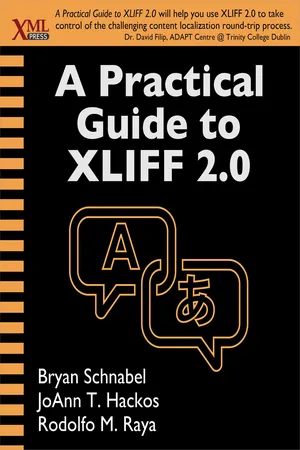
- 230 pages
- English
- ePUB (mobile friendly)
- Available on iOS & Android
A Practical Guide to XLIFF 2.0
About this book
A Practical Guide to XLIFF 2.0 introduces the OASIS XLIFF standard. Companies use XLIFF to standardize the exchange of source and localized content with localization and translation vendors.
You will learn how to get the most from the XLIFF standard, use best practices in your translation workflow, extend XLIFF, and use the XLIFF modules.
This book is for localization coordinators, technical writers, content management system vendors, localization service providers, and consultants who want to incorporate XLIFF into their customers' publishing workflow.
Getting Started introduces XLIFF, the translation process, and the major parts of XLIFF, including the core and modules.
Applied XLIFF describes how XLIFF supports translation of XML (including DITA), websites, office documents, graphics, and software user interfaces.
XLIFF Core: introduces the XLIFF core features, including:
- Preserving document structure
- Marking up text for translation
- Segmentation and sub-flows
- Fragment identification
- Extensibility
XLIFF Modules: introduces the XLIFF modules, including:
- Translation Candidates
- Glossary
- Format Style
- Metadata
- Resource Data
- Change Tracking
- Size and Length Restriction
- Validation
XLIFF 2.0 Structure: describes the XLIFF 2.0 schemas, including the core structural and inline elements and module schemas.
Examples: detailed examples, including XSL code, for transforming XML source files into and out of XLIFF.
Frequently asked questions
- Essential is ideal for learners and professionals who enjoy exploring a wide range of subjects. Access the Essential Library with 800,000+ trusted titles and best-sellers across business, personal growth, and the humanities. Includes unlimited reading time and Standard Read Aloud voice.
- Complete: Perfect for advanced learners and researchers needing full, unrestricted access. Unlock 1.4M+ books across hundreds of subjects, including academic and specialized titles. The Complete Plan also includes advanced features like Premium Read Aloud and Research Assistant.
Please note we cannot support devices running on iOS 13 and Android 7 or earlier. Learn more about using the app.
Information
| A Practical Guide to XLIFF 2.0 |
 |
eBook Introduction
Bryan Schnabel, JoAnn T. Hackos, and Rodolfo M. Raya
October, 2015
Preface
1. About this book
- exchange XLIFF files
- consume translated XLIFF files
- use best practices in the XLIFF translation workflow
- validate XLIFF files
- follow the processing requirements defined in the XLIFF standard
- extend XLIFF in compliance with the standard
- add modules and core features to future versions of XLIFF
2. The audience for this book
- Localization coordinators at large companies who currently use out-dated methods to manage translations and now must manage XML text, software strings, RTF, Graphics, DITA, HTML, SVG, and more.
- New localization coordinators who need guidance and better methods to manage their translation projects.
- Technical writers who are responsible for managing translations without the assistance of localization coordinators.
- Those who prefer to handle translation using open standards rather than proprietary systems.
- Localization Services Providers (LSP) who prefer to handle DITA and other content using open standards rather than proprietary systems.
- Content Management System (CMS) vendors and other software developers who want to incorporate XLIFF into their publishing pipeline.
- Consultants who want to incorporate XLIFF into their customers’ publishing pipelines.
3. Typographical conventions for this book
Constant-width font- XML
<elements>, XMLattributes, and code examples. - Italic font
- Glossary terms and emphasis.
4. The authors
4.1. Bryan Schnabel
4.2. Rodolfo M. Raya
4.3. JoAnn Hackos
5. Acknowledgments
5.1. Bryan
5.2. Rodolfo
5.3. JoAnn
| Getting Started |
Chapter 1. Introducing XLIFF
Table of contents
- A Practical Guide to XLIFF 2.0